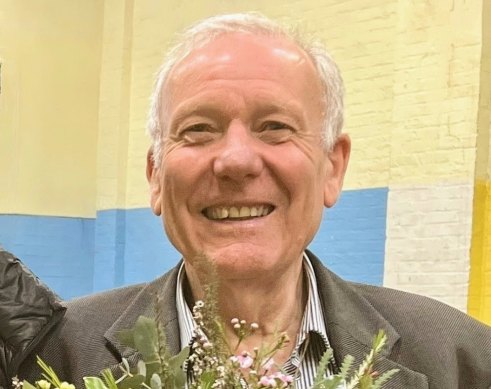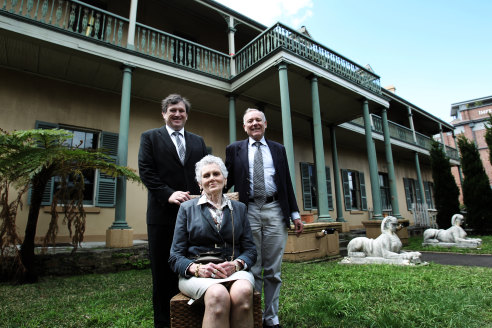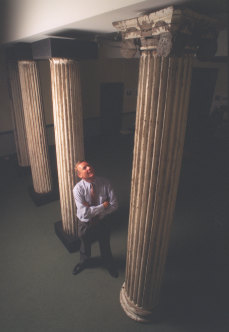National Trust curator with vision preserved cultural treasures
IAN STEPHENSON: 1955 – 2024
From his earliest years, Ian Stephenson had a fascination for the world around him – not just for what was there but why it was there and the story behind it. As a boy, he took the train from Epping to the city on school holidays just to explore, and some years later rode his pushbike to St Albans, north of the Hawkesbury River, just to “soak up the history”.
In his long career in conservation, with the National Trust of Australia, the Glebe Society and many other such organisations, he fulfilled his vision of preserving our cultural treasures.

Ian Stephenson in 2022.
Ian Malcolm Stephenson was born in Sydney on December 1, 1955, son of a pharmacist, Austin Stephenson, and Noreen (nee Stevens). Growing up in Epping, he went to Newington College in 1965, entering the junior school.
His father, dissatisfied with his academic performance, enrolled him in Scots College Bathurst in 1973 to complete his HSC. Stephenson then went to Tasmania, bought a house in Hobart and enrolled to study history at the University of Tasmania. He got a job in taxation and got to know an architect, Clive Lucas, who was engaged on a government-funded conservation project for Port Arthur, and became acquainted with archaeologists also engaged, entertaining them at his home.
In 1988, following a stint in Canberra where he worked at the historic Lanyon Homestead, he bought a terraced house in Glebe and did a diploma of heritage studies at Sydney University. “Ian never stayed still,” Clive Lucas said. “He moved to Armidale, bought a house there and worked in the library at the University of New England. He went to Adelaide, bought a house and ran the National Trust in South Australia.”

Greta and Peter Moran with Ian Stephenson, a director of the National Trust, at the front of the Jupiter Hall at Paddington.Credit: Fairfax
In 1990, after a stint as the inaugural curator of the Liverpool Bicentennial Museum and the adjoining colonial Georgian-era Collingwood House, Stephenson started with the National Trust in Sydney, where he became senior curator. Scott Carlin, managing director of the National Trust (Tasmania), said Stephenson had “energetically” managed several concurrent Centenary of Federation grants for properties such as Dalwood at Branxton, Cooma Cottage and the site of Henry Parkes’ Federation oration in Tenterfield.
At Old Government House, Stephenson worked initially with Clive Lucas, restoring much of the early 19th century detail. Carlin said that Stephenson “reinterpreted the house to reflect the Macquarie period, with paint schemes and interior furnishings made by the National Trust sewing machines … Ian secured volunteer commitment worth many thousands of dollars per year over more than two decades. Ian made significant contribution on several fronts. He played an important role in recognising and conserving the heritage of the New England region.”
Stephenson was part of the National Trust team that successfully secured the Centenary of Federation Grant to restore the Tenterfield School of Arts. In 1993, he arranged for an exhibition at Old Government House of the sitting room furniture used by former Prime Minister Ben Chifley.

Ian Stephenson views columns from a historic house which is part of the exhibition Sydney – Past and Present, in 1997.Credit: Fairfax
In these years, Stephenson spread his range widely, attending the Victorian Society Summer School in America, dedicated to architecture, art, landscape and preservation. In 1999, he took up a Royal Collections Trust Scholarship to attend an Attingham Summer School in London, devoted to similar cases in Britain.
The scholarship took him to the Royal Collection Studies at Windsor Castle and various Attingham Study Weeks. He linked with leading heritage thinkers throughout the world. Carlin said: “As a custodian of historic sites Ian charmed and befriended people who might otherwise have opposed change.”
Stephenson’s niece, Rachel Brookes, said: “Ian was also able to point out the finer features of All Saints Parish Church, our local Anglican Church in Maidenhead in England. This to our untutored eye was a fairly standard Victorian church, but Ian knew it is a Victorian Grade 1 listed building designed by George Edmund Street, an assistant to Gilbert Scott. Without people like Ian the special buildings we pass every day could easily be overlooked, changed for the worse or forgotten and pulled down. We always learnt something when we were with him.”
Stephenson became a trustee and then chairman at the Copland Foundation, whose roles included sponsoring acquisitions and conservation for Australian historic places, together with scholarships at Attingham Trust. He had a host of other appointments, including being director of Historic Places, ACT, CEO of the National Trust in South Australia, curator of collections at the University of New England, and board membership of the National Trust of Australia in 2010.
In 2018 Stephenson held a major exhibition at Old Government House, Parramatta, Tales from the East: India and New South Wales, showing a different aspect of the house, and attracted new audiences by using governor Lachlan Macquarie’s 20-year career in India to explore early colonial associations and the continuing influence of Indian heritage.

Ian Stephenson speaking at a housing rally.
Ian Stephenson became president of the Glebe Society, followed by roles as vice president, planning convener and heritage convener. Glebe Society president Duncan Leys said that Stephenson had conducted numerous campaigns to retain Glebe’s character, including arguing for the retention of Philip Cox-designed medium density public housing with their well-established communities of public tenants. He also assisted another local Glebe organisation, Hands off Glebe.
His sister, Helen Brookes, said: “His knowledge shone through: he pointed out not only the historical buildings, how they had changed and what he would do to preserve them, but also the in-fill buildings, those that had been sensitively done and those which were perhaps, in his view, a missed opportunity.”
Leys said: “He took a proactive role in opposing development that threatened the heritage, particularly in Parramatta, and did not think the Powerhouse Museum should be moved from Ultimo. His most memorable visits were possibly to Government House Calcutta, the former vice-regal summer retreat at Barrackpore and Lutyens and Baker’s Viceroy’s House, New Delhi. Ian’s most recent trip was to South America. He was planning further trips to southern India and to Tonga to see the royal palace.”
But this was to be cut short. On October 24, Duncan Leys, not having heard from Stephenson for a few days, checked on him at his home in Glebe and found him dead. The Sydney City Council honoured him at his passing with a Mayoral Minute.
Ian Stephenson is survived by his sister, Helen Brookes, brother-in-law Michael and nieces Rachel, a medical practitioner, and Anthea. His funeral will take place at Christ Church St Laurence, Railway Square, where he was a parish councillor. Duncan Leys said: “Ian was always good-humoured, generous and funny with a wicked sense of humour. Glebe and our country have suffered an enormous loss, and I will miss him greatly.“
Start the day with a summary of the day’s most important and interesting stories, analysis and insights. Sign up for our Morning Edition newsletter.